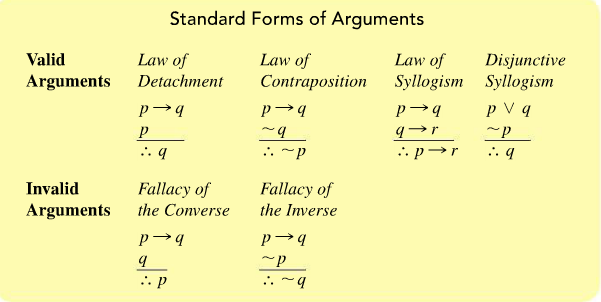- We will consider arguments of the form
-
Premise 1: statement
Premise 2: statement
...
Premise n: statement
---------------------
Conclusion: statement
- For example
If we make home made ice cream then we will get a headache.
We made home made ice cream
Therefore we got a headache.
- An argument is valid when the conclusion follows from a given set of premises.
- This is true if the conjunction of the premises imply the conclusion.
- To show this
- Write the premises and the conclusion in symbolic form
- show p1 ∧ p2 ... ∧ pn → c is a tautology.
- For our example:
If we make home made ice cream then we will get a headache.
We made home made ice cream
Therefore we got a headache.
p: we make home made ice cream
q: we get a headache
p → q
p
∴ q
show (p → q ) ∧ p → q is a tautology.
| p | q | p → q | p → q ∧ p | p → q ∧ p → q |
|---|
| T | T | T | T | T |
| T | F | F | F | T |
| F | T | T | F | T |
| F | F | T | F | T |
Since the final row is all T, the statement is a tautology and the argument is valid.
- How about
If we make home made ice cream then we will get a headache.
We got a headache.
Therefore we made home made ice cream
- Note, the truth table tells us where the argument is not valid.

